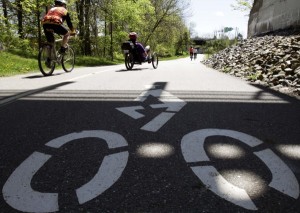 In a state known for Wasatch Front commuter traffic, wide roads filled with SUVs, and a massive pollution-related inversion, just how do bikes and cyclists fit into the mix? Is Utah considered a Bike-Friendly state? and does the growing number of cyclists within the state feel safe? These questions can be properly analyzed in comparison with other states’ laws, regulations, and surveyed respondent results.
In a state known for Wasatch Front commuter traffic, wide roads filled with SUVs, and a massive pollution-related inversion, just how do bikes and cyclists fit into the mix? Is Utah considered a Bike-Friendly state? and does the growing number of cyclists within the state feel safe? These questions can be properly analyzed in comparison with other states’ laws, regulations, and surveyed respondent results.
Components for Bike-Friendliness
Bicycle Friendly Association’s Standards
The Bicycle Friendly Association was established in 2000 to determine the criteria for bicycle safety and culture standards. Each year, the BFA rates each of the 50 states based on their number of bike-friendly businesses and universities, cyclist communities, accident rates, and bike-friendly laws. This criteria includes the education necessary for the next generation of safe cyclists (and cyclist-friendly motorists and citizens). The BFA then makes recommendations for new cyclist legislation, community involvement and provides a road map for implementing changes.
Utah’s Placement
In a national context, Utah was ranked 14 out of 50 in 2013, one spot lower than in the previous year. By the BFA’s criteria, the west coast has the best bike-friendly qualifications in the nation, with Utah not falling too far behind. According to the BFA results, Utah only has one university that is “Bike-Friendly” (University of Utah), and a relatively low number of bike-friendly businesses and communities (8 and 4, respectively). Thus, despite a smaller culture for cycling, Utah records a comparatively lower rate of bike-related accidents. The establishment of new legislation in the last few years, including 6 new laws in 2013, also helps to boost Utah’s favorable rating. These laws were supported by the BFA and have been recommended to be renewed, as some of the laws are temporary/exploratory.
Looking to the Future…
For the road ahead to improving further bike safety and enhancing the increasingly vibrant cyclist culture, several advocacy groups have some suggestions. The Utah Advocacy Journal encourages a commitment to the following principles:
- increased planning and infrastructure funding,
- building more awareness between vehicles and bikes,
- and, most importantly, establishing a statewide Complete Streets Policy
A “Complete Streets Policy” involves a comprehensive policy for all inhabitants of the road: motorists, cyclists, pedestrians, and public transportation. Local bike-friendly movements, such as the Road Respect Campaign, are also pushing for an improved relationship with the Utah Department of Transportation to better meet the safety needs of cyclists in Utah.
Currently, Salt Lake City is leading the way in bike-friendliness in Utah having recently received a silver medal from the BFA for its plans to extend the number of bike lanes and increase its public funding specifically for cycling.
Christensen and Hymas advocates increased safety for the well-being of cyclists within the state of Utah. We have been personally responsible for drafting new cycling safety legislation in the past few years. Bicyclists need to be given all the support they need to ride safely. As personal injury lawyers, we know how difficult it is to sustain injuries during biking accidents. If you or someone you know has been involved in a cycling accident and experienced injuries, we recommend you call us at (801)506-0800 for a free consultation. You deserve to be compensated for the injuries, loss of income, and pain and suffering that you have received from another’s negligence.
Image courtesy of bangordailynews.com
